As soon as the spring birds begin chirping and temperatures creep into the sweater-free zone, my eager longing for the season’s bounty of produce results in gross overbuying.
Perhaps you have the luxury of a lush garden or you stock up at the local market – whatever the case may be, chances are that in the coming months, you too will find yourself hoarding mountains of ripe produce.
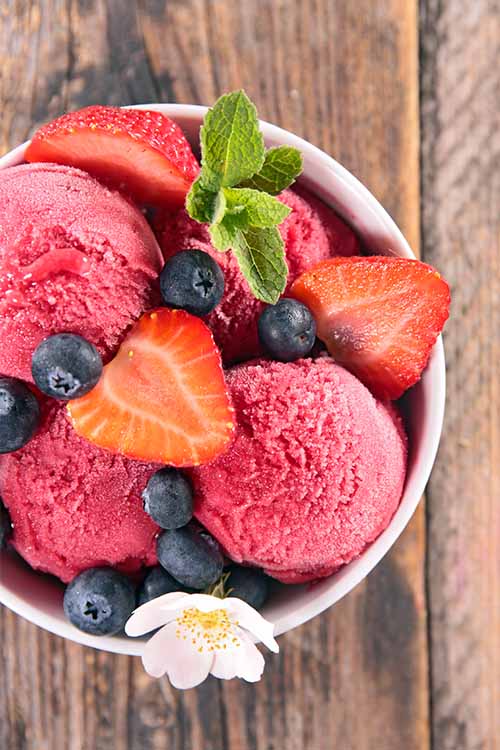
What better excuse to make a fresh batch of homemade sorbet?
While the premise of sorbet is quite simple – just a frozen puree of fresh fruit – learning to master the smooth, scoopable texture can be overwhelming. Delicate ratios of sugar, water, fiber, and pectin can all affect your end result.
Save investing in a refractometer or destroying your wholesome treat with unwanted chemical stabilizers, is it possible to achieve professional-grade sorbet at home?
Armed with just a bit of food science, you can successfully transform all your quickly-ripening produce into the perfect afternoon treat.
What Makes it Work?
At its most basic, sorbet is comprised of three things: fruit, sugar, and air. Almost any fruit can make a successful, smooth frozen treat, but not without a few small adjustments, according to fruit family.
The lack of fat makes the other ingredients a tad more finicky than working with an ice cream. In order to decipher the adjustments needed, it is important to understand the role of sugar and air.
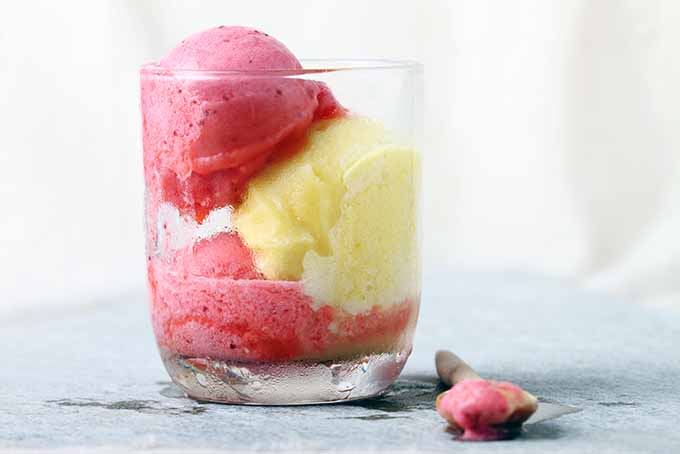
Sugar is a magical ingredient. Amidst masses of nutritional guidelines warning of its ill effects, the wonder of sugar’s scientific properties is oftentimes lost. But understanding sugar is key to achieving the perfect texture.
As the percentage of sugar in a liquid increases, the freezing point decreases. Since sorbet is primarily made of sugar and water, hitting the correct ratio will determine whether you end up with a block of ice, a sloppy mess, or that sweet spot in between.
When spinning the fruit puree, your machine is not just bringing the temperature down – it is incorporating a lot of air. This air adds volume to the sorbet while decreasing the size of the ice crystals that form as the water in the puree freezes. If the ice crystals get too big, your otherwise lovely snack will fail to melt smoothly in your mouth.
Two Methods
There are two main methods that you can use to turn your fruit into a spinnable puree. The simplest involves blending simple syrup with fruit.
Simple syrup is equal parts sugar dissolved in water. While it is easy to just buzz your fruit and syrup together, the high volume of water increases the potential for icy crystallization, which can hurt your end texture.
The second method involves macerating your fruit in sugar, then processing it into a puree. In under an hour, sugar breaks down the fruit, creating its own liquid rather than requiring the addition of water. This is my preferred method, as it results in a smoother finish.
The Sugar Ratio
The ideal sorbet has a sugar percentage between 20 and 30 percent. Since you most likely don’t feel the need to purchase a special tool to measure the sugar content of your fruit, the safest way to start is with a ratio of 5 parts fruit to 1 part sugar.
For the simple syrup method, this would mean 5 cups of fruit and 2 cups of syrup. For the maceration method, use 5 cups of fruit and 1 cup of sugar.
The easiest way to blend the base is with an immersion blender, though a food processor or basic blender will work too.
If you’re looking for an immersion blender for your own kitchen, check out Foodal’s guide here.
Once your puree is blended, you can test your sugar level with an egg. At the ideal viscosity, a raw egg will float perfectly in your base. It may sound crazy, but it really works!
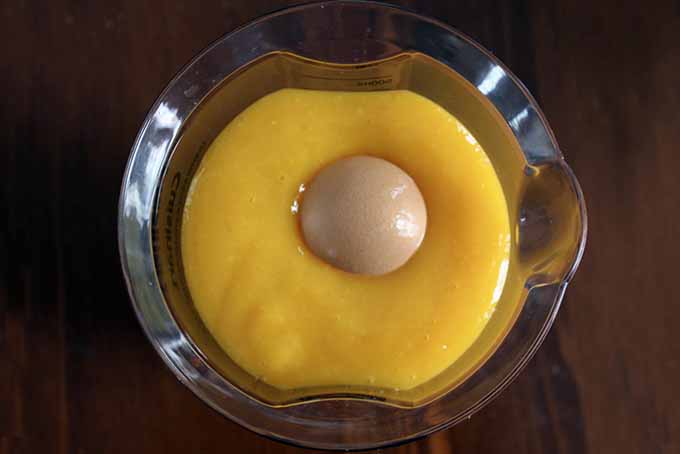
Wash and dry an egg, lower it carefully into your fruit puree, and check to see if it floats. If not, incorporate additional sugar or simple syrup, lest you end up with just a colorful chunk of ice.
Glucose syrup, corn syrup, or invert sugar can improve the texture of the final sorbet, and also help to keep it from freezing solid.
In these syrups, sucrose has been broken down into glucose and fructose. They have more body than simple syrup and resist crystallization. Try exchanging up to 1/2 cup of sugar with glucose or corn syrup.
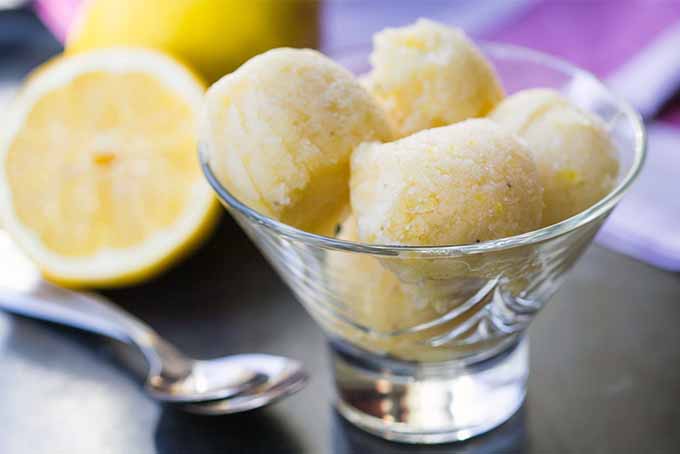
Alternative sweeteners such as honey, agave, or maple syrup will not upset the sugar ratio – however, their stronger flavors might overpower your fruit. If you plan to use an alternative sweetener, don’t replace all of the sugar. Try using 1/4 cup of the alternative with 3/4 cup of sugar.
Use the egg test to check your sugar and liquid ratios! If the egg sinks, you can add either granulated sugar or your syrupy alternative – just taste as you go to ensure that your alternative does not mask the flavor of the fruit.
Artificial sweeteners will not work in sorbet as they do not contain any sugar, and thus will not impart the important chemical properties necessary for creating the treat’s structure. If you are concerned about added sugars, try making a fruit-only alternative like a frozen Yonanas puree.
Fruit Families
The volume of fiber in your fruit can affect the end result. Fruits with higher fiber contents will lower the water content of the puree, allowing it to freeze with less interference from ice crystals.

For this reason, stone fruits and berries make for great starter sorbets. Tart green apples or fleshy mangoes work nicely as well. The presence of fiber will create a thicker puree, which will result in a smoother sorbet without the addition of stabilizers.
Some other excellent fruit options include:
- Cherries
- Kiwi
- Nectarines
- Peaches
- Pears
- Pineapple
- Plums
- Kiwi
- Strawberries
Rhubarb also makes a nice sorbet, however, it is important to cook the vegetable after macerating with sugar in order to help break down the stalks, cut the acidity, and develop its wonderful earthy, tart flavor.
But who doesn’t love the tang of lemon, or vibrant blood orange? When working with citrus, pay particular attention to the sugar content.
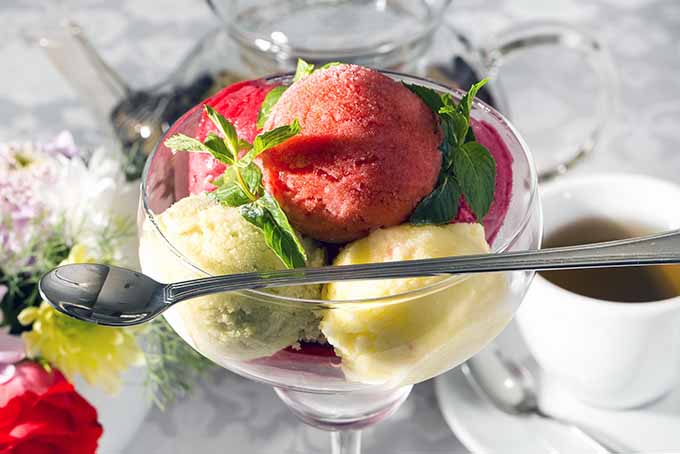
The lack of fiber in citrus juice means the water content will be very high. Using enough sugar is vital to avoiding an icy end result. This is where the egg test really comes in handy. If the egg floats, you’re good to go!
You can also eliminate the likelihood of rock-hard sorbet with the addition of a natural stabilizer.
Stabilizing Add-Ins
So, you’ve made a lovely sorbet. You’ve allowed it to set in the freezer for an hour or two, and it graces your tongue with the smoothness of ice cream.
The next day, you go back for seconds only to discover that the once-delicate dessert is now stiff enough to break a spoon.
Over time, the air you so carefully churned into the sorbet begins to deflate. This affects the eating experience significantly. One option is to allow the sorbet to melt in the fridge overnight and simply re-churn.
But if you don’t care to add the extra effort of re-freezing, another option is to incorporate a stabilizer into the original base. The three best options are alcohol, pectin, and gelatin.
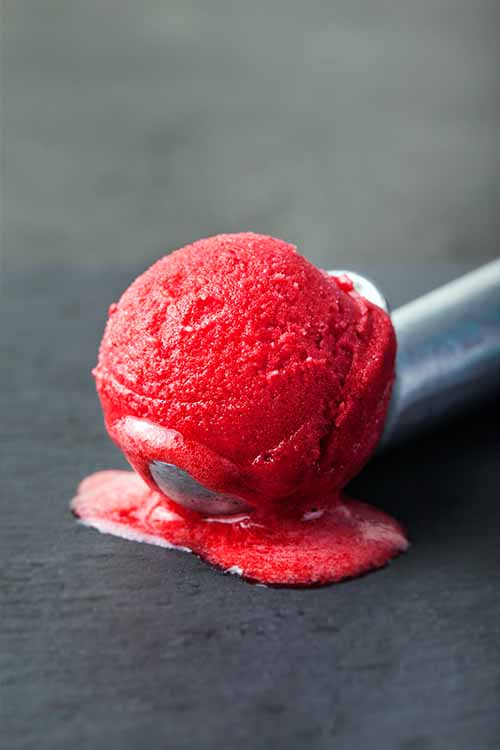
A few tablespoons of liquor not only brings an additional complexity to the dish, it lowers the freezing point, which inhibits the final product from turning into ice. Be careful not to add more than a tablespoon per cup of base, or else the freezing point will be so low you’ll end up with a cup of slush!
Lower alcohol additions like wine or sake offer a bit more leeway, but be aware that this also means they increase the water content of your base. With these, try using up to two tablespoons per cup of base.
Some fun pairings include:
- Cucumber and St. Germaine (get the recipe here!)
- Peach and Chardonnay
- Pineapple and Rum
- Plum and Cabernet
- Grapefruit and honey
Fruit pectin is another easy to use, natural stabilizer – particularly useful when working with citrus. Since citrus juice has such a high water content and it’s low fiber, pectin will bring a bit more viscosity to the juice, decreasing the size of your ice crystals.
Use 1 teaspoon of pectin per quart of juice. It is necessary to boil the pectin with sugar for one full minute to ensure that it is properly hydrated.
If you’re making a quart of citrus sorbet, boil 3/4 cup sugar, 1/2 cup water, 1/2 cup citrus juice, and 1 teaspoon fruit pectin for one minute. After cooling, stir in the remaining 3 cups of citrus juice and churn.
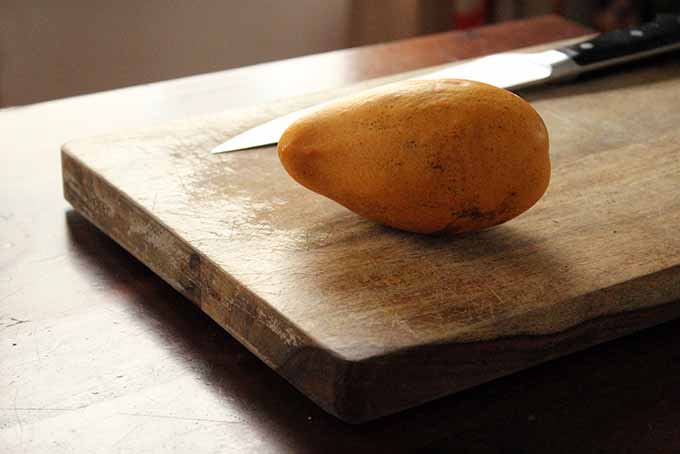
Boiling will alter the flavor of the juice a bit, which is why I say to only boil part of it. I typically avoid adding extra water wherever possible, because it means cutting the flavor and increasing the size of the ice crystals. You also need to boil some acid with the sugar to activate the pectin, so using the fruit juice accomplishes this.
Pectin can be purchased in powdered form at most grocery stores, or anywhere that you can buy canning supplies. Another option is to add a few tablespoons of fruit jam or jelly, since these already contain a small amount of pectin.
Gelatin is another handy stabilizer. It adds great body to the base, which significantly reduces the size of the ice crystals that develop during freezing. 1 teaspoon of powdered gelatin or 2 sheets of sheet gelatin can improve a quart of base.
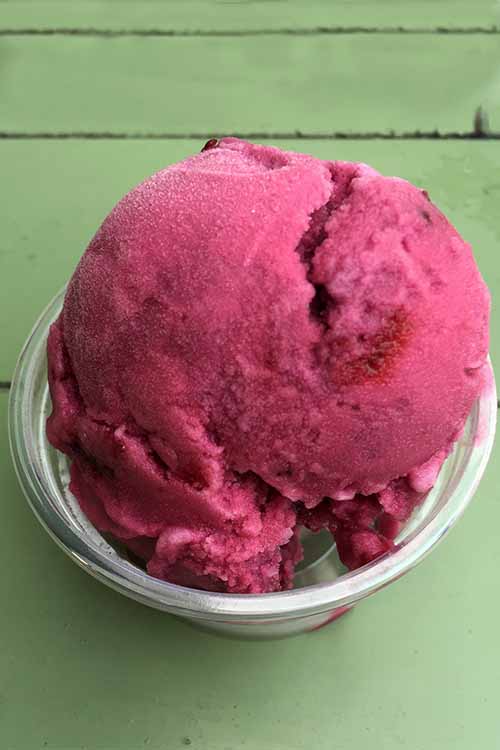
Bloom (soften) the gelatin in 1/4 cup of water or juice. Heat 1/4 cup puree or juice, and stir into the bloomed gelatin to dissolve. The fruit just needs to be heated enough to dissolve the gelatin, so it doesn’t need to come up to a boil.
The gelatin could be dissolved in water instead if you choose, but I always try to avoid adding water as much as possible. Let cool on the counter for half an hour, then add to the remaining sorbet base, chill, and churn.
Churn, Baby, Churn
Congratulations, you are now fully equipped to make your own batch of sorbet! With so many fruit options springing into season, the variations are endless.
Once you’re comfortable transforming your fruit into a stable base, you can experiment by adding additional layers of flavor like balsamic vinegar, fresh thyme, or spicy cayenne.
If your mouth is now watering for this tasty homespun snack but you’ve yet to invest in an ice cream maker, be sure to check out our guide to choosing the best on the market!
You know what’s really similar to sorbet? Sherbet! Check out one of our favorite recipes here.
Photo credits: Shutterstock, except where otherwise indicated. Photos by Kendall Vanderslice, © Ask the Experts, LLC. ALL RIGHTS RESERVED. See our TOS for more details.
About Kendall Vanderslice
Kendall’s love of food has taken her around the world. From baking muffins on a ship in West Africa and milking cows with Tanzanian Maasai, to hunting down the finest apfelstrudel in Austria, she continually seeks to understand the global impact of food. Kendall holds a BA in Anthropology from Wheaton College and an MLA in Gastronomy from Boston University, and has worked in the pastry departments of many of Boston’s top kitchens. Based in Somerville, Massachusetts, Kendall helps to run a small community supported bread bakery and writes about the intersection of food, faith, and culture on her personal blog, A Vanderslice of the Sweet Life.



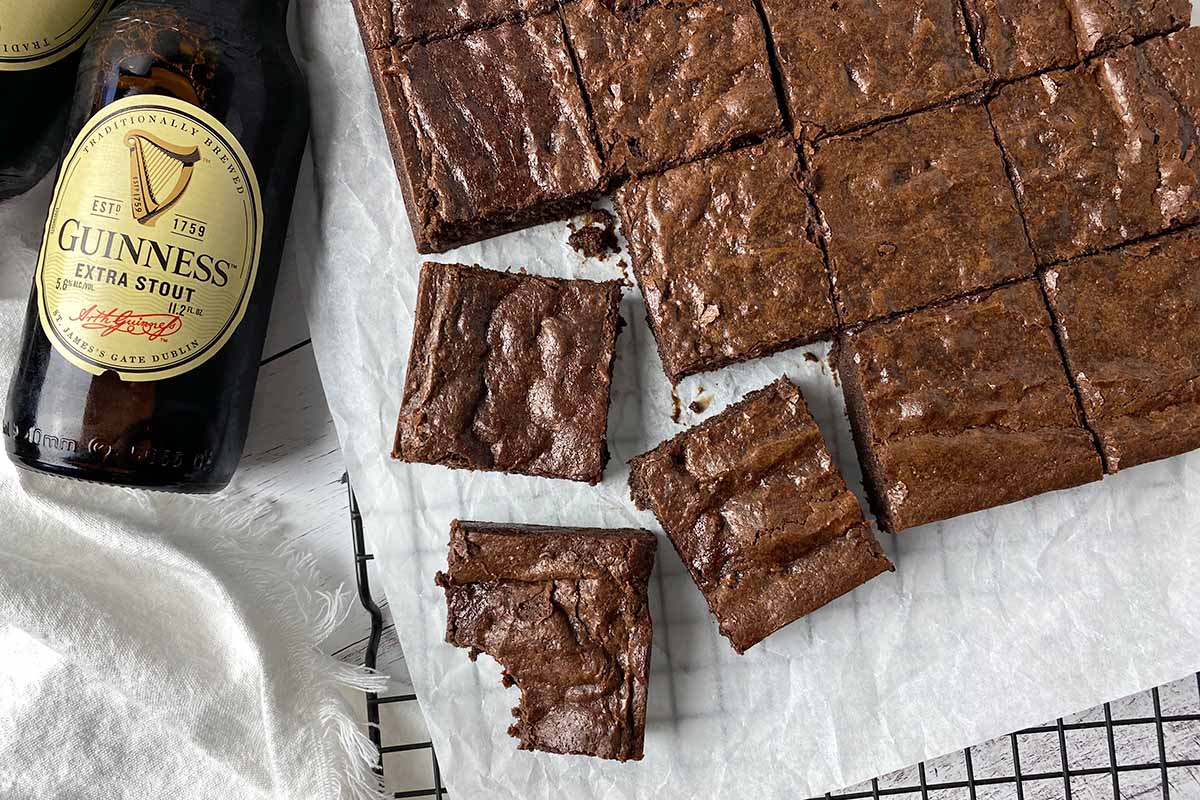
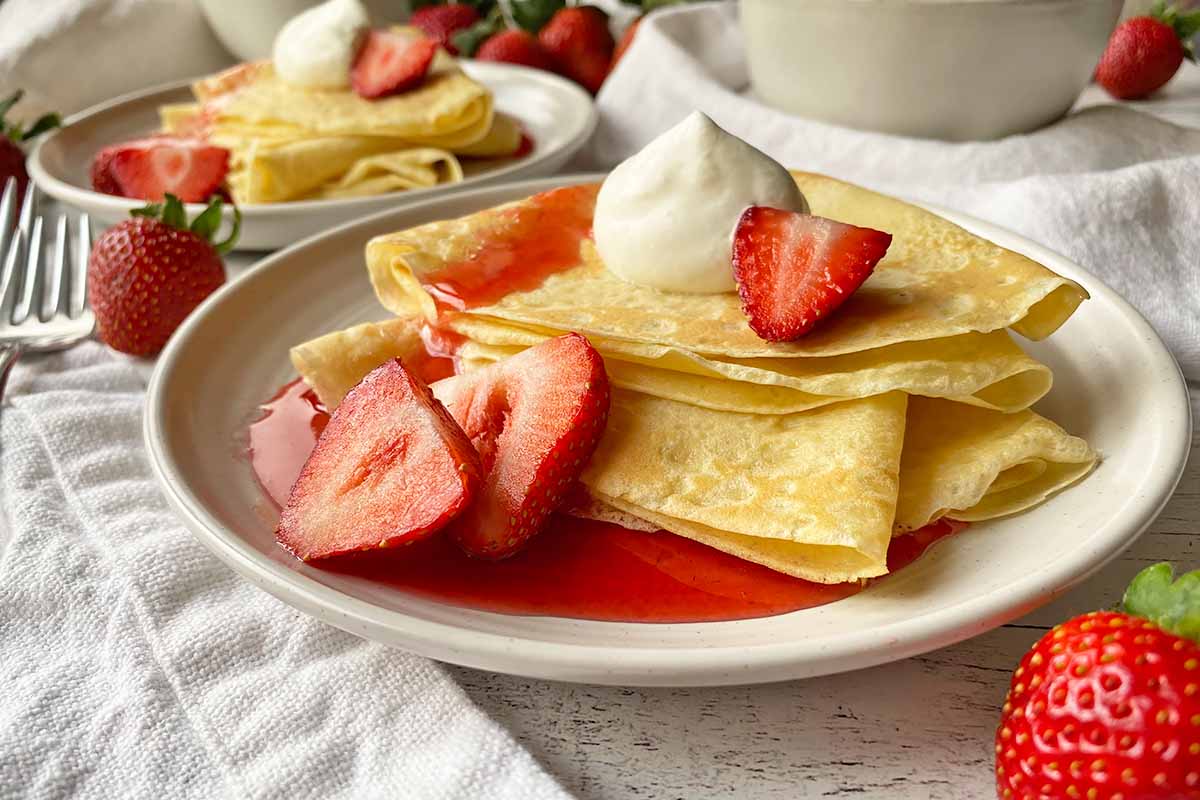

This is one of my favorite treats, specially after a heavy dinner. I’ve been making only the lemon version and I confess that sometimes I haven’t obtained the desired results, now I know I was following the wrong recipes!
Thank you for explaining the science about sugar and water and for all the great tips, I’m going to follow your lead and macerate the fruit in sugar, and I’ll make sure to use the floating-egg method. In this season there are so many kinds of fruit I can experiment with and I’m looking forward to trying the Pineapple and Rum combination.
Hi Snarya,
Yes the egg test is particularly helpful with a lemon sorbet, or anything that does not have much pulp! Let us know how it works out!
I loved these tips! I will use them for summer.
This sounds delightful. I can’t wait to try it for myself in the upcoming warmer months. I do tend to grab for more fresh fruits this time of year, so this would be ideal if I can just get the sugar/water ratio correct. I will follow the above instructions and like Snarya, will try the fruit in sugar technique. I think I’d like to try mixing flavors together in a serving bowl. Pineapple and mango together, for example, sounds absolutely mouthwatering.
You can also mix flavors together before you freeze! After macerating the fruit, try blending the pineapple and mango together. That does sound like a delicious combination.
This is gonna be fun to make! Thanks!
I’ve never attempted to make frozen desserts before – I’m not sure why I haven’t, perhaps I was just nervous to ever try. It’s not something I’ve had any experience with at all. I guess, I just don’t know how to work with it. However, I am very thankful I found this page! You had a very informational guide with a lot of good tips and tricks for someone like me. I would never have thought of some of these. So you have managed to save me a lot of terrible errors.
I can’t wait to try this out!
Thank you for sharing Kendall Vanderslice, great article indeed. Out of the two methods above, I find the “sugar ratio” one more intriguing… So I’m definitely up for that!
I have been using my blender to make these types of treats but now I will definitely look into this. I always enjoy finding new and creative ways to make desserts that are healthy and fun to make. This page does so accordingly. Quite a find. I do look forward to more usage of different fruits and super foods that I can add in though so I can maintain my health as well and not over-indulge.
I didn´t see it mentioned in the post, but what do you think about bananas, in my opinion there are many fruits that have a natural taste blend with bananas and the bananas add a more creamy and ´fatty´ texture which gets it closer to the texture of ice cream. Strawberries and pinapples are two of my favorite to add with bananas, but now because of where I live, Mangos are very cheap also ( they taste similar to a peach).
Hi Azrile,
Bananas are definitely an option for sorbet! Because they are so creamy with a low water content, I would use the simple syrup method rather than the maceration. Mango and banana sounds delicious!
I absolutely love sorbet, but I never considered making it on my own. If I’m able to make anything resembling the results that are shown in those pictures, I’d be more than willing to give it a try, haha! My personal favorite fruits for sorbet are strawberries and kiwi, but I’d be very interested in pineapple and maybe even blueberry. Making some kind of blue raspberry sorbet would be absolutely amazing in my opinion. Perhaps even apple may be a viable option. Thanks for these tips! I’ll be sure to try to implement them into my sorbet making process if or when I decide to dive in and do it!
Wow, I had no idea about all the details that went into making it properly. Very interesting.
This sounds like such a perfectly refreshing treat for those hot days ahead. What fun it would be to make with the grandkids as well.
I see several flavors in my future.
I have not done anything like this myself. But I appreciate the many tips given here. I especially love the ‘egg method’ to test the sugar ratio. NOT stupid at all. I like to learn out of the ordinary tips like this. Keep it up!
I love sorbet! Especially with summer and warmer weather right around the corner. It is probably my favorite summer dessert. So refreshing and it cools me off. My four year old son loves the fruity flavors too. I think that with home made sorbets you have a lot more to work with and love that you can be creative. Of course this is with everything but I just love creating my own flavors! I agree with you that the addition of liquor will bring out the flavors more, although I have never tried this technique. Thank you so much for this great tutorial/recipe! I will be using it throughout the summer to make delicious sorbets.
Cheers,
Jamie
I’m extremely excited to try this out. I’ve been looking for some new recipes to try over the summer and this seems to be the perfect thing to make. I’ve never tried my hand at sorbet but I think I’ll be able to make some just fine.
Sounds delicious, but a bit complicated for me! Maybe you can do a Sorbet for Dummies edition-a more basic recipe without the science parts (although those are fascinating). I’m wondering also if there is a sugar-free version since fruit is already so laden with sugar; do any of the sweeteners work?
My husband is a huge fan of sorbet! As I’ve gotten older and cared more about eating healthily I’ve loved finding recipes like this one that allow me to make a well loved treat at home with ingredients I buy fresh and know how to pronounce. I’m not the greatest in the kitchen yet, but I think I’m going to attempt this! It probably won’t come out as gorgeous as yours, but I’m sure it’ll taste great. Thanks for sharing! XO
Sorbet, sorbet.. one of my favorites when you need to make up something on the fly! It’s also the most healthy dessert you can make that tastes amazing. You definitely have to try out a lot of combinations before you find the perfect mix.
Thank you so very much for posting this! I have been looking all over the internet to find some of the secrets to making a good Sorbet. I am very interested in learning how to make my own sorbet, and this article was so helpful! I appreciate your interest in supplying recipes for healthy homemade desserts! Thank you again for the great read!
What’s with all the boiling? I make the most amazing sorbet without any heat. It’s fresher tasting, has a wonderful texture, and requires minimal effort.
Thanks for your question, Peter. Apologies if this wasn’t clear!
The boiling option is to activate the pectin, if you’re using it as a stabilizer. Sometimes sorbet loses its lovely texture after too much time spent in the freezer, and this helps to prevent that. We typically do this only with a citrus flavored dessert, and even then, only a tiny bit of the fresh juice is added to the boiling liquid since acid + heat is needed to get the pectin going.
Thank you for a useful commentary on sorbet. I’ve got some wonderful apple cider but, because of it’s low density, I thought in might need a stabilizer of some sort. Your explanation of alternative stabilizers was extremely helpful. I chose gelatin, and it worked perfectly. My mother taught me the floating egg test for sugar content. You’re right, it works every time. Thanks again.
I have a question on the egg method. I have seen it referenced elsewhere with the added note that only about a nickel or quarter sized amount of the egg should be visible from the surface. Meaning your base is too sweet if any more of the egg is visible. And so, my lemon sorbet (with pectin) attempt did not freeze well. I think boiling the simple syrup with the pectin for a full minute increased the sweetness of the base a ton. I defrosted the attempt, added what felt like a gallon more lemon juice to bring down the sweetness (but I must say the egg was not very responsive to the addition so I even resorted to adding some water). Anyhow, it seems to be OK now.